Jumping in with Both Feet: The Benefits of Aquatic Physical Therapy for You and Your Patients

One of the best ways to enhance your resume is to specialize in one or more physical therapy modalities. If a dip in the water sounds appealing to you, then aquatic physical therapy may be the ideal addition to your skillset. It’s suitable for all ages, and you can use it alongside, or in place of, your other physical therapies.
The therapeutic benefits make it a smart choice for many of your patients. The buoyancy of the water takes pressure off the joints and muscles, while the warmth of the water soothes sore or stiff muscles. And there’s no denying the power of water when it comes to soothing the mind and soul. Best of all, it’s been found to be very effective for treating any number of disorders and conditions, including cardiovascular/pulmonary, neuromuscular, musculoskeletal, and integumentary (skin).
And let’s be honest: sometimes heading to the water is simply a great way to break up the monotony of land-based PT exercises and keep things interesting.
So, what are you waiting for? Dig out your bathing suit from the depths of your closet and start learning about how aquatic therapy can benefit both your patients and your career.
Aquatic therapy is versatile and effective for patients with many conditions and injuries.
One of the things that makes aquatic therapy such a great form of physical therapy is that it’s safe and effective for patients of nearly any age and with many types of conditions or injuries.
While working alongside, or under the direction of, a physical therapist, you’ll be able to implement aquatic therapy exercises for your patients with neurological or orthopedic injuries, sports or occupational injuries, or muscle weakness due to chronic or acute illnesses or injuries. Depending on the needs, goals, and physical abilities of your patients, you’ll help them carry out exercises aimed at improving muscle strength and power, flexibility, gait and locomotion, balance and coordination, aerobic capacity, endurance, and relaxation.
Just some of the conditions you can use aquatic therapy to treat include:
Arthritis
Balance disorders
Cerebral palsy
Chronic pain
Osteoarthritis
Rheumatoid arthritis
Parkinson’s disease
Multiple sclerosis
Traumatic brain injury
Stroke
Aquatic therapy exercises involve therapeutic exercise, manual therapy, breathing strategies, and functional training. There’s also plenty of tools your patients will use to make their aquatic therapies even more beneficial—and sometimes more fun! Your bag of tricks may include everything from noodles and water weights to resistance bands, flotation rings, and kickboards. Some rehabilitation centers even have specially designed aquatic stationary bicycles and treadmills that used in the water.
Since aquatic therapy is offered in a variety of settings, including sports medicine clinics, hospitals, outpatient rehab centers, and even senior living centers, making it part of your professional repertoire, either through an internship or certificate program, can be a great way to gain a competitive professional edge.
But it’s not for everyone.
While most of your work will take place in the shallow end of a swimming pool or therapy pool, it’s not appropriate for all your patients. For starters, if your client has a fear of the water, now is not the time to encourage them to get in the water. Remember: your job is to provide aquatic therapies, not encourage your patients to overcome a fear of the water.
There are other conditions that’ll likely not make a good aquatic therapy patient. For example, it’s likely that your patients with open wounds, seizure disorders, incontinence, or hepatitis A won’t be able to participate in aquatic therapy. Patients with respiratory disorders like COPD may also not be good candidates for aquatic therapy, as would anyone with a chlorine allergy.
Before you dive in, learn the ins and outs of aquatic therapy.
Providing aquatic therapy is not as easy as bringing your patient into the pool and performing land-based exercises in the water. So, before you add aquatic therapy to your collection of therapeutic exercises, you’ll need a good understanding of hydrodynamic principles, water chemistry, and risk management, and you’ll want to get trained in everything from water safety to aquatic therapy techniques.
You can learn a lot by working under a physical therapist trained in aquatic therapy through an internship, and you can also complete a training program through the Aquatic Physical Therapy Section of the American Physical Therapy Association (APTA) and receive the Certificate in Aquatic Physical Therapy Clinical Competency designation (CAPTCC).
The CAPTCC designation isn’t a requirement for providing aquatic physical therapy, but it can certainly go a long way to establishing yourself as a trusted aquatic therapy assistant.
You can also familiarize yourself with aquatic therapy by completing continuing education courses through the Aquatic Therapy and Rehab Institute and the Aquatic Therapy Section of the APTA. You may also consider taking the more informal route and shadowing a physical therapist or volunteering your time at a facility that offers aquatic therapy.
Πρόσφατα Άρθρα
Super Delicious! Quick and Easy Purees Made With “Superfoods”
As your baby starts to eat more solids, you’re going to want to give them the most nutrient-packed foods possible; aka, superfoods! Superfoods are loaded with nutrients that promote development and...

5 Tips for Running Errands with Kids
Running errands is very different when kids are involved! Taking your child with to you to run errands can be a bit challenging. From taking extra time getting them ready to leave the house to mana...

Talking to Your Child About Winning and Losing
Life with all its ups and downs and everything in-between can sometimes feel like a roller coaster. Being able to deal with the ride is a skill that takes time to learn. So how do you help young ch...
